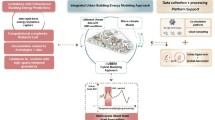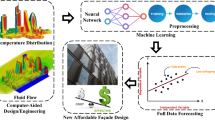Abstract
The ability to take into account reflections from obstructions is of fundamental importance in building energy simulation (BES), because reflections can have a substantial influence on solar gains. In BES tools, this ability is often implemented duplicating functionalities that have already been solved efficiently in lighting simulation tools. This happens because importing those functionalities from a lighting simulation tool (source) into a BES tool (target) is usually a complex operation producing non-portable results. This article demonstrates that this ability can be imported modularly and portably without intervening in the internals of the two tools. This can be obtained by: (1) creating, in the source tool, pairs of models which are analogue—on the one hand—to the original model in the target tool, and—on the other hand—to the model in the target tool hypothetically enriched with some predictive ability only available in the source tool; (2) measuring, at each time step, the ratio between the performances predicted by the source tool as regards the two analogue models; (3) re-scaling, at each time-step, the performance predicted by the target tool on the basis of that ratio. When appropriate analogue models are utilized, this strategy enables distinct simulation tools to work like an integrated computing unit.
Similar content being viewed by others
References
Allegrini J, Dorer V, Carmeliet J (2015). Coupled CFD, radiation and building energy model for studying heat fluxes in an urban environment with generic building configurations. Sustainable Cities and Society, 19: 385–394.
Appel A (1968). Some techniques for shading machine renderings of solids. In: Proceedings of AFIPS Conference, San Francisco, CA, USA.
Bartell FO, Dereniak EL, and Wolfe WL (1981). The theory and measurement of bidirectional reflectance distribution function (BRDF) and bidirectional transmittance distribution function (BTDF). In: Proceedings of SPIE (Society of Photo-Optical Instrumentation Engineers) 0257, Radiation Scattering in Optical Systems.
Beausoleil-Morrison I (2002). The adaptive conflation of computational fluid dynamics with whole-building thermal simulation. Energy and Buildings, 34: 857–871.
Bouyer J, Inard C, Musy M (2011). Microclimatic coupling as a solution to improve building energy simulation in an urban context. Energy and Buildings, 43: 1549–1559.
Brunetti GL (2015). Program for keeping into account the solar reflections from obstructions in ESP-r on the basis of irradiance ratios. Fileset. 2015–17. (a) http://figshare.com/articles/modish_pl/1466767
Brunetti GL (2019): Second case study on the use of irradiance ratios. figshare. Dataset. https://doi.org/10.6084/m9.figshare.7542932.v4
Citherlet S, Clarke JA, Hand J (2001). Integration in building physics simulation. Energy and Buildings, 33: 451–461.
Clarke JA (2001). Energy Simulation in Building Design. London: Butterworth Einemann.
Clarke JA, Janák M (1998). Simulating the thermal effects of daylightcontrolled lighting. Building Performance BEPAC Journal, issue 1 Spring, 1998.
Compagnon R (2004). Solar and daylight availability in the urban fabric. Energy and Buildings, 36: 321–328.
Cook RL, Torrance KE (1982). A reflectance model for computer graphics. ACM Transactions on Graphics, 1: 7–24.
Crawley DB, Lawrie LK, Pedersen CO, Strand RK, Liesen RJ, et al. (2001). EnergyPlus: Creating a new-generation building energy simulation program. Energy and Buildings, 33: 319–331.
de la Flor FS, Domínguez SA (2004). Modelling microclimate in urban environments and assessing its influence on the performance of surrounding buildings. Energy and Buildings, 36: 403–413.
DOE (2015). EnergyPlus engineering reference: The reference to EnergyPlus calculations. US Department of Energy. Available at http://energyplus.net/sites/default/files/pdfs_v8.3.0/Engineering Reference.pdf.
ESRU (2001). Data model summary ESP-r Version 9 Series. ESRU Publication, University of Strathclyde, Glasgow. Available at http://www.esru.strath.ac.uk/Documents/ESP-r_data_doc.pdf
Freitas S, Catita C, Redweik P, Brito MC (2015). Modelling solar potential in the urban environment: State-of-the-art review. Renewable and Sustainable Energy Reviews, 41: 915–931.
Goral CM, Torrance KE, Greenberg DP, Battaile B (1984). Modeling the interaction of light between diffuse surfaces. Computer Graphics, 18: 213–222.
Gracik S, Heidarinejad M, Liu J, Srebric J (2015). Effect of urban neighborhoods on the performance of building cooling systems. Building and Environment, 90: 15–29.
Greenberg A (1989). Validation of Radiance. Report, Lawrence Berkeley National Laboratory, USA. Available at http://buildings.lbl.gov/sites/default/files/lbid-1575.pdf
Grobe LO (2019). Photon mapping in image-based visual comfort assessments with BSDF models of high resolution. Journal of Building Performance Simulation, 12: 745–758.
Gros A, Bozonnet E, Inard C (2011). Modelling the radiative exchanges in urban areas: A review. Advances in Building Energy Research, 5: 163–206.
Hachem C, Athienitis A, Fazio P (2011). Investigation of solar potential of housing units in different neighborhood designs. Energy and Buildings, 43: 2262–2273.
Han Y, Taylor JE, Pisello AL (2017). Exploring mutual shading and mutual reflection inter-building effects on building energy performance. Applied Energy, 185: 1556–1564.
Hand JW (1998). Removing barriers to the use of simulation in the building design professions. PhD Thesis, University of Strathclyde, UK.
He XD, Torrance KE, Sillion FX, Greenberg DP (1991). A comprehensive physical model for light reflection. ACM Computer Graphics, 25: 175–186.
Heidarinejad M, Gracik S, Sadeghipour Roudsari M, Khoshdel Nikkho S, Liu J, et al. (2016). Influence of building surface solar irradiance on environmental temperatures in urban neighborhoods. Sustainable Cities and Society, 26: 186–202.
Idczak M, Groleau D, Mestayer P, Rosant JM, Sini JF (2010). An application of the thermo-radiative model SOLENE for the evaluation of street canyon energy balance. Building and Environment, 45: 1262–1275.
Janák M (1997). Coupling building energy and lighting simulation. In: Proceedings of the 5th International IBPSA Building Simulation Conference, Prague, Czech Republic.
Janák M (2003). Whole building energy simulation with complex external shading devices. In: Proceedings of the 8th International IBPSA Building Simulation Conference, Eindhoven, Netherlands.
Jensen HW (1996). Global illumination using photon maps. In: Proceedings of the 7th Eurographics Workshop on Rendering.
Kajiya JT (1986). The rendering equation. In: Proceedings of the 13th Annual Conference on Computer Graphics and Interactive Techniques.
Keller A (1997). Instant radiosity. In: Proceedings of the 24th Annual Conference on Computer Graphics and Interactive Techniques.
Klucher TM (1979). Evaluation of models to predict insolation on tilted surfaces. Solar Energy, 23: 111–114.
Kubilay A, Derome D, Carmeliet J (2018). Coupling of physical phenomena in urban microclimate: A model integrating air flow, wind-driven rain, radiation and transport in building materials. Urban Climate, 24: 398–418.
Kuhn TE, Herkel S, Frontini F, Strachan P, Kokogiannakis G (2011). Solar control: A general method for modelling of solar gains through complex facades in building simulation programs. Energy and Buildings, 43: 19–27.
Lafortune EP, Willems YD (1993). Bi-directional path tracing. In: Proceedings of the 3rd International Conference on Computational Graphics and Visualization Techniques.
Li D, Liu G, Liao S (2015). Solar potential in urban residential buildings. Solar Energy, 111: 225–235.
Lomanowski BA, Wright JL (2012). The Complex Fenestration Construction: A practical approach for modelling windows with shading devices in ESP-R. Journal of Building Performance Simulation, 5: 185–198.
Mardaljevic J (1995). Validation of a lighting simulation program under real sky conditions. Lighting Research and Technology, 27: 181–188.
Mazria E (1979). The Passive Solar Energy Books. Emmaus, PA, USA: Rhodale Press.
Miguet F (2007). A further step in environment and bioclimatic analysis: The software tool Solène. In: Proceeding of the 10th International IBPSA Building Simulation Conference, Beijing, China.
Moore F (1985). Concepts and Practices of Architectural Daylighting. New York: Van Nostrand Reinhold.
Muneer T, Kinghorn D (1998). Luminous efficacy models—Evaluation against UK data. Journal of the Illuminating Engineering Society, 27: 163–170.
Muneer T, Fairooz F, Zhang X (2003). Sky luminance and radiance distributions: a comparison based on data from Bahrain, Israel, Japan and Europe. Lighting Research and Technology, 35: 11–17.
Oren M, Nayar SK (1995). Generalization of the Lambertian model and implications for machine vision. International Journal of Computer Vision, 14: 227–251.
Perez R, Ineichen P, Seals R, Michalsky J, Stewart R (1990). Modeling daylight availability and irradiance components from direct and global irradiance. Solar Energy, 44: 271–289.
Perez R, Seals R, Michalsky J (1993). All-weather model for sky luminance distribution—Preliminary configuration and validation. Solar Energy, 50: 235–245.
Pisello AL, Taylor JE, Xu X, Cotana F (2012). Inter-building effect: Simulating the impact of a network of buildings on the accuracy of building energy performance predictions. Building and Environment, 58: 37–45.
Pisello AL, Castaldo VL, Taylor JE, Cotana F (2014). Expanding Inter-Building Effect modeling to examine primary energy for lighting. Energy and Buildings, 76: 513–523.
Queiroz N, Westphal FS, Ruttkay Pereira FO (2019). The use of EnergyPlus for daylighting analysis and design optimization of shading devices. In: Proceedings of the 16th International IBPSA Building Simulation Conference, Rome, Italy.
Reinhart CF, Walkenhorst O (2001). Validation of dynamic RADIANCE-based daylight simulations for a test office with external blinds. Energy and Buildings, 33: 683–697.
Robinson D, Stone A (2004). Solar radiation modelling in the urban context. Solar Energy, 77: 295–309.
Robinson D, Stone A (2005). A simplified radiosity algorithm for general urban radiation exchange. Building Services Engineering Research and Technology, 26: 271–284.
Robinson D, Haldi F, Kämpf J, Leroux P, Perez D, et al. (2009). CITYSIM: Comprehensive micro-simulation of resource flows for sustainable urban planning. In: Proceedings of the 11th International IBPSA Building Simulation Conference, Glasgow, UK.
Segovia B, Iehl JC, Mitanchey R, Péroche B (2006). Bidirectional instant radiosity. In: Proceedings of the 17th Eurographics Symposium on Rendering Techniques.
Shurcliff WA (1979). New Inventions in Low-Cost Solar Heating. Andover, MA, USA: Brick House Publishing Company.
Srebric J, Heidarinejad M, Liu J (2015). Building neighborhood emerging properties and their impacts on multi-scale modeling of building energy and airflows. Building and Environment, 91: 246–262.
Strachan PA, Kokogiannakis G, MacDonald IA (2008). History and development of validation with the ESP-r simulation program. Building and Environment, 43: 601–609.
Strachan P, Svehla K, Heusler I, Kersken M (2016). Whole model empirical validation on a full-scale building. Journal of Building Performance Simulation, 9: 331–350.
Tokuyoshi Y, Ogaki S (2012). Real-time bidirectional path tracing via rasterization. In: Proceedings of the ACM SIGGRAPH Symposium on Interactive 3D Graphics and Games.
Wang B, Png CE (2019). Solar irradiance simulation for evaluating thermal comfort in urban environment. Architectural Science Review, 62: 14–25.
Ward GJ, Rubinstein FM, Clear RD (1988). A ray tracing solution for diffuse interreflection. In: Proceedings of SIGGRAPH’88 Conference, Atlanta, GA, USA.
Ward GJ (1992). Measuring and modeling anisotropic reflection. Computer Graphics, 26: 265–272.
Ward GJ (1994a). The RADIANCE Lighting Simulation and Rendering System. In: Proceedings of the SIGGRAPH’94 Conference, Orlando, FL, USA.
Ward GJ (1994b). Response to a user request in the Radiance Digest, vol. 2, number 8 (part 1a) 1994: Daylight calculations. Available at http://radsite.lbl.gov/radiance/digests_html/v2n8_1a.html
Ward Larson G, Shakespeare R (1999). Rendering with Radiance. The Art and Science of Lighting Visualization. San Francisco, CA, USA: Morgan Kaufmann.
Whitted T (1980). An improved illumination model for shaded display. Communications of the ACM, 23: 343–349.
Willmott AJ, Heckbert PS (1997). An empirical comparison of radiosity algorithms, Report, Carnegie Mellon University.
Yang X, Grobe L, Wittkopf S (2013). Simulation of reflected daylight from building envelopes. In: Proceedings of the 13th International IBPSA Building Simulation Conference, Chambéry, France.
Author information
Authors and Affiliations
Corresponding author
Rights and permissions
About this article
Cite this article
Brunetti, G.L. Utilization of irradiance ratios for calculating the effect of reflections from obstructions in building energy simulation. Build. Simul. 14, 945–967 (2021). https://doi.org/10.1007/s12273-020-0722-2
Received:
Revised:
Accepted:
Published:
Issue Date:
DOI: https://doi.org/10.1007/s12273-020-0722-2




